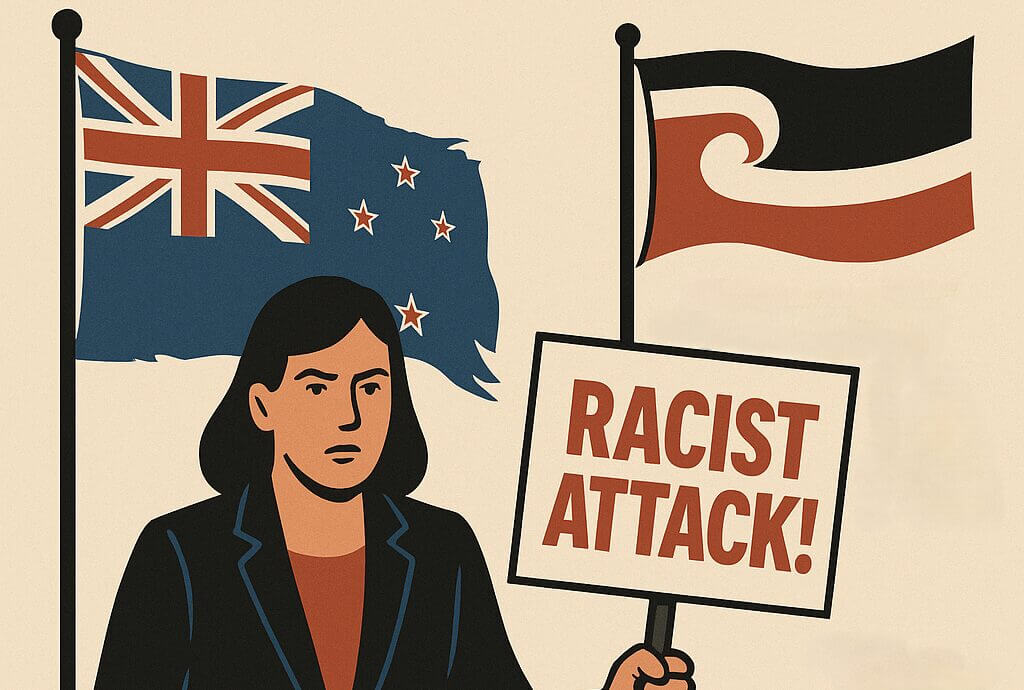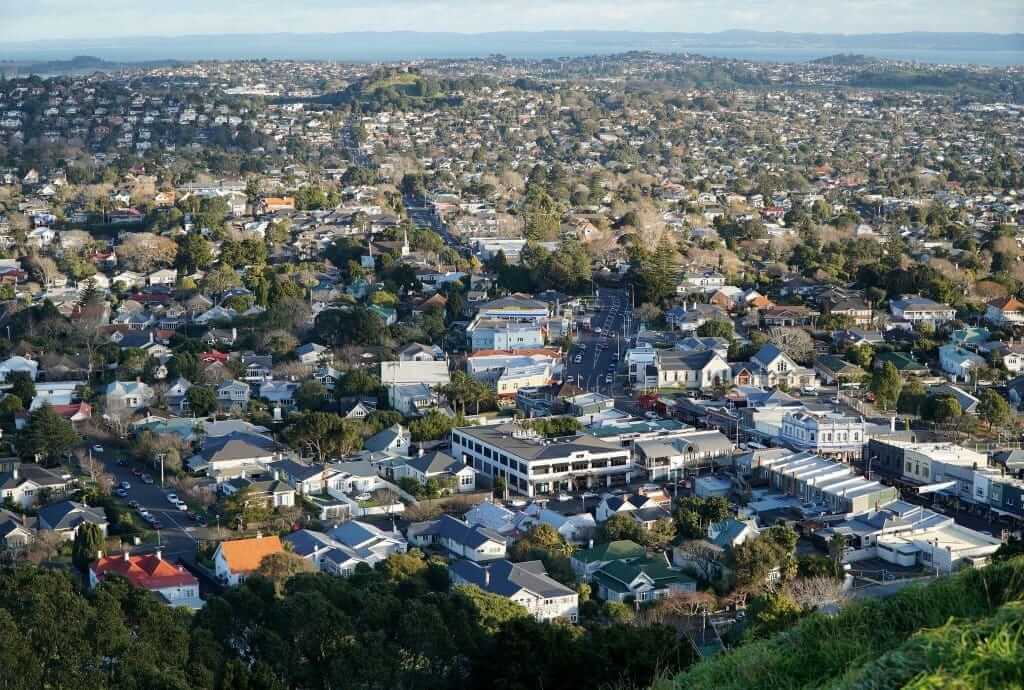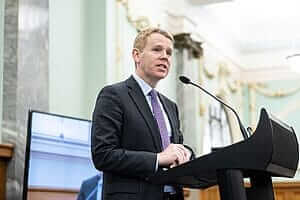By Ian Wishart
EXECUTIVE SUMMARY
A spot audit of NIWA’s 2023 flagship Annual Climate Summary report and some of its predecessors over the past five years has uncovered multiple major errors that cumulatively exaggerate the impact of climate change and drive public fear.
Based on a detailed analysis of historic newspaper reports containing temperature, rainfall and other weather data and comparing them to NIWA’s published climate summaries, the audit has found
- Claimed temperature records that were never real records
- Claimed rainfall records that were never real records
- NIWA published false information on New Zealand’s biggest historic cyclone, creating a false narrative that Cyclone Gabrielle was bigger and driven by climate change
- Cherrypicked data is being used to exaggerate the apparent frequency of climate records being broken
- The practice of reporting records by month is giving NIWA twelve times more opportunities to claim records in any given location, creating media and public confusion and a sense of relentless overwhelming climate change
- NIWA is unaware of New Zealand’s highest temperatures
- NIWA’s claim that only three days in our history have experienced temperatures higher than 40C is wrong: the real figure is nearly triple that
- That there’s little evidence of climate change increasing extreme maximum temperatures in New Zealand, absolute records from a century ago are still intact
A year ago, the original Climate of Fear study on New Zealand historic storms found huge gaps in NIWA’s knowledge of our pre-industrial climate.
Now, nearly 11 months later, a new study finds NIWA continuing to ignore the past at a time when the rest of the world are rapidly expanding their climate change research to include weather data from digitised old newspapers.
NIWA’s continued reliance on its own limited climate records is a systemic research failure, resulting in false or misleading information being provided to government, clients, climate researchers and the public.
The NIWA reports in the spotlight are its annual climate summaries, published every year to provide a comprehensive breakdown of trends in New Zealand’s climate. The documents themselves use varying shades of orange and reddish brown to create the graphic impression of heat and climate urgency, but the data inside has huge holes.
The most obvious example of manipulation is the “records began” column. NIWA would have you believe that Rotorua has no temperature records earlier than 1972, or that Wellington, founded in 1839, has no records before 1931. Although Queenstown records began in 1871, the 1860s goldmining towns Alexandra and Clyde have no temperature records earlier than 1992 and 1978 respectively. Whangarei has no temperatures before 1967, but its rainfall records date back to 1943. Why the difference? Who knows. Town after town, most of their records since settlement are not in the database.
Confused? You should be. NIWA’s climate records are like swiss cheese, continually compromised by decades – even a century – of missing data. With a budget of more than $160 million a year, you’d expect to be seeing more bang for the taxpayer buck.
Against that background, this audit shows NIWA has made almost zero effort in its 32 years of existence to backfill the missing data from other historical documents. That systemic failure has allowed this report to wipe the floor with NIWA, just as the storm report did last year.
NIWA doesn’t know what it doesn’t know. But you are about to find out just how bad their climate research database is.
TOO HOT TO HANDLE: MAIN ARTICLE
“The year was remarkable for the frequency of floods in the Auckland and, especially, the Hawke’s Bay provinces. In the latter they were very severe, and the damage was of disastrous proportions.”
That quote might describe our weather in 2023, but you may be surprised to learn that it came from the 1938 Met Service report to parliament.
Eighty-five years later, lessons from history loom large as major new errors and omissions have emerged in NIWA’s 2023 Climate Summary report, just days after its release, making it the second flawed report in as many years.
The government’s self-proclaimed leading climate research agency, which burns through about $160 million in revenue and funding each year, continues to produce research summaries that – because the errors are systemic, not accidental – its clients like local council planners can’t trust as they’re little better than fiction.
The systemic problem at the heart of NIWA research failings is that the agency has made little to no effort, in three decades of existence, to fill massive gaps in its databases. This leaves NIWA flying blind, not knowing what it doesn’t know.
What it doesn’t know is serious.
CYCLONES: FALSE INFORMATION PUBLISHED BY NIWA
Take Ex-Cyclone Gabrielle. The Niwa Summary says:
“On 12 February, Gabrielle began impacting Northland and Auckland. In central Auckland, the air pressure fell to 971.5 hPa, surpassing that which was observed during the Cyclone of 1936 (973.5 hPa). On 14 February, Gabrielle’s centre of circulation drifted eastward toward East Cape, passing just kilometres offshore during the evening. A MetService analysis indicated a central pressure of 965 hPa. Gabrielle then moved away from the mainland.”
As identified in the original Climate of Fear report last year, NIWA research is incredibly weak on historical storms. The reference to the 1936 Cyclone by NIWA is simply wrong – they don’t have the data.
“The recovery of meteorological data from old documentary sources is of great significance for meteorological and weather research”
– Royal Met. Society UK
Thankfully, old newspaper records do, and climate scientists in Australia, the USA and Europe are furiously cross-checking their traditional databases against what they now regard as “the treasure trove” of newly digitised old newspapers.
“Historical records from the 18th and 19th centuries provide a detailed picture of Australia’s pre-industrial climate before instrumental observations become influenced by global warming. This provides a unique opportunity to examine weather extremes produced purely by natural variability for comparison with recently observed variability and extremes,” writes Aussie climate scientist Joelle Gergis.
Gergis and her team are using crowdsourced volunteers on “citizen science platform Zooniverse” to scan through thousands of old reports recovering historic weather data.
“Once complete, these records will be continuous sub-daily datasets, providing a treasure trove for the study of Southern Hemisphere climate variability and extremes. Importantly, they will fill crucial data gaps in global datasets, improving the reliability of historical climate analysis.”
In Britain, the Royal Meteorological Society is crowing about recovering vital climate data from 5000 Spanish newspaper articles.
“The recovery of meteorological data from old documentary sources is of great significance for meteorological and weather research. We describe our recovery of a meteorological series from the late nineteenth and early twentieth century from the pioneering A Guarda Observatory in Galicia (Spain). Data series were obtained from meteorological notes appearing in the newspaper La Integridad as published at the time. In total, we recovered data from over 5000 newspapers using more than 60 000 individual measurements.”
A group of UK scientists have even been using New Zealand’s old newspapers to research historic floods.
Even NIWA has been known to crow when it has discovered information, not in its database, from old newspapers – such as finding out New Zealand’s coldest temperature was -25.6C at Ranfurly in 1903:
“I was quite excited to find the record. It’s like detective work,” NIWA climate scientist Georgina Griffiths remarked in 2017.
Quite.
Interestingly, the agency verified the newspaper record by comparing it to other historic news reports and data to check for consistency. The NIWA article doesn’t mention it but they almost certainly stumbled on this report from the Central Otago town of Gladbrook, which reached a low of -25C on the same day. That’s how corroboration works.
Thus, NIWA, set up in 1992, only discovered in 2017 New Zealand’s coldest recorded temperature, from an old newspaper not their master database.
So, now that you know why trawling through old newspapers is valid climate science, let’s find out how NIWA’s 2023 report claiming Gabrielle was bigger than the 1936 Cyclone is wrong, and how these systematic errors are wasting taxpayer money, possibly endangering lives and property through their flawed analysis, and making NIWA a laughing stock.
Storm research 101: the lower the hPa number, the lower the atmospheric pressure in the eye of the storm and therefore the stronger and faster the winds will be (racing in to fill the vacuum) and the higher the storm surge – king tides caused because of the lower air pressure allowing the sea level to rapidly rise. In plain English, high pressure systems essentially weigh more heavily on the ocean, forcing the sea level down, while low pressure storms are lighter, and the sea rises accordingly.
It’s the storm surge that causes the ocean to rise high enough to flood roads and wash away buildings and cars.
NIWA says Gabrielle was 965 hPa. A century ago they measured barometric pressure in inches of mercury, and 965 hPa is equivalent to 28.5 inches of mercury.
NIWA also says the 1936 Cyclone was only 973.5 hPa (28.75 inches), not as low and therefore not as powerful as Gabrielle.
They are wrong. Three barometers near the tip of the North Island recorded what appears to be the deepest cyclonic low measured in NZ. One, at Cape Maria van Diemen, dropped to 28.5 inches of mercury (965 hPa), identical to Gabrielle’s deepest low. The second unit, a calibrated device at Kaitaia, went even lower to 28.00 inches of mercury (948.2 hPa) as the cyclone passed overhead.
The third device, at Doubtless Bay and just six metres above sea level, plunged to 27.91 inches of mercury (945 hPa), the deepest low known in NZ.
The 1936 storm, like Gabrielle, devastated the North Island and had our modern infrastructure been in the firing line back then the damage may well have been more extensive than Gabrielle. But that’s not the point of this story – the take home message is that NIWA doesn’t know that 1936 was far more powerful than Gabrielle. It simply doesn’t have the data and its failure to factcheck against publicly available records is embarrassing.
The 1936 news reports even join the dots to show how lazy NIWA’s research was, noting that the 973 hPa low that Cyclone 36 reached in Auckland probably wasn’t the full story:
“The pressure at Auckland yesterday morning was 28.76 inches (973.9 hPa), and at the centre it must have been lower.”
As you’ve now seen, it was much lower, 945 hPa. If it was obvious to news reporters in the 1930s that there was a deeper low to be found, it should have been far more obvious to 21st century climate scientists. If NIWA scientists had bothered to read the historical reports they would have found that caveat and discovered the far north readings. But they didn’t.
Instead, their flagship report, the 2023 Annual Climate Summary, contains major errors that could have been avoided.
Adding insult to injury, NIWA in 2023 had weather satellites and a vast network of automated sensors, so it had the advantage of being able to track and measure Gabrielle every second. Last century, that technology didn’t exist. It’s possible a satellite or remote electronic weather station back in 1936 would have found an even deeper low. It’s just blind luck that three barometers in far north homes were able to measure and corroborate.
RAINFALL RECORDS THAT DON’T REALLY EXIST
Then there’s rainfall extremes. In February 1936, Whangarei was swamped.
“The rainfall at Whangarei for the 24 hours ending at 9 o’clock this morning was 11.41 inches (290mm),” reported the Press Association, the morning after Cyclone 36 had swept through.
Someone at NIWA had done their job, as the same data appears in NIWA’s Historical Weather Events Database:
“Whangarei recorded 11.41 in (29.0 cm) of rain in 24 hours (Return Period over 150 years).”
So, knowing that, why on earth did NIWA sign off on its 2023 Annual Climate Summary Report containing the false statement: “Whāngarei recorded 216 mm between 9:00 am 12 February – 9:00 a.m. 13 February, its wettest February day on record.”
Really? Is 216mm in 2023 a bigger deluge than 290mm in February 1936? Does NIWA have no Year 3 maths graduates on staff?
“Claimed record after claimed record, there’s evidence that NIWA’s cherrypicked data is being used (and coloured in dark red for the most extreme bits) to bolster the narrative that extreme climate records are being broken more frequently now”
-Ian Wishart
The reason for this incredible own goal from New Zealand’s premiere climate research agency can be sheeted home to hubris. Despite admitting the HWE data is verified before uploading, NIWA says it doesn’t use it, preferring to rely on its other database, CliFlo:
“The website Ian Wishart has based his opinions on is not New Zealand’s national climate database,” the agency said, sniffily, in a statement published after the Climate of Fear report.
“Wishart has conflated the Historic Weather Events website with the New Zealand National Climate Database [CliFlo] that is used by NIWA and climate scientists nationally and internationally to analyse weather events and trends in the climate. NIWA’s New Zealand National Climate Database includes official observations back to the 1850s, including some descriptions of significant weather events of the time.
“The Historic Weather Events website that Wishart has based his study on is a catalogue that was created to collate descriptive details on impacts and hazards from weather events. It is not an official type of meteorological record. It has gaps because it contains information gathered from newspaper articles, journals, books and reports that periodically come to light. Gathering these sources and validating them takes significant time and is an ongoing process.”
The take-home from the arrogant news release is, ‘trust us, we know what we’re doing, our real database has all the official data covered’.
Yet clearly it doesn’t. If CliFlo was fit for purpose Cyclone 36 would correctly be listed as a 945 hPa record-breaking storm, not 973 hPa, and NIWA would not have published the claim – contradicted by its own secondary database – that Whangarei suffered its wettest day ever during Cyclone Gabrielle with a 216mm rainfall, when the real record was 290mm in 1936.
But that’s not the worst of it by a longshot. Claimed record after claimed record, there’s evidence that NIWA’s cherrypicked data is being used (and coloured in dark red for the most extreme bits) to bolster the narrative that extreme climate records are being broken more frequently now.
Akaroa, on Banks Peninsula, is listed in 2023 as having its highest 24 hour rainfall – 199mm or 7.8 inches – since records began in 1977. That may be true, but there are records of a 212mm (8.36 inches) downpour in 1941. NIWA’s records are incomplete.
If you didn’t know the real historic record, you’d come away from reading the NIWA Summary convinced that we are getting record rainfall because climate change has turbocharged it beyond anything that happened before. Instead, the truth is that Akaroa didn’t break the 1941 record.
Waipawa, in the North Island, is claimed to have suffered its most extreme 24 hour rainfall since records began in 1945, with a 117mm (4.6 inch) sluicing during Cyclone Gabrielle. Again, the implication from these lists is that the modern climate is more extreme. Yet, earlier records, evidently lost to NIWA, show downpours of 148mm (5.83 inches).
The 2023 Summary says Gabrielle also delivered record rainfall to the Chateau station on Mt Ruapehu, with 154mm (6.06 inches) in 24 hours. However historical records that NIWA clearly doesn’t have, show a 7.5 inch (191mm) washout over just five hours in March 1933. The storm washed out bridges, derailed an overnight passenger train in an eerie foreshadowing of Tangiwai two decades later, caused a plane crash and widespread flooding.
NIWA says the Anniversary Day floods last year delivered Auckland’s biggest ever rainfall since “records began” as early as 1853, with a peak of 265mm (10.4 inches) in 24 hours at Mangere. In April 1924, though, a storm lashed the Auckland region delivering a peak intensity of 356mm (14 inches) over the north of the city in only five hours!
Although the event is listed in the NIWA Historical database, the agency does not mention the massive rainfall tallies recorded in two locations, the second being an unofficial reading of 15 inches near Silverdale, but clearly corroborating the first gauge. The distance between both gauges was 30 km, meaning the catchment was larger than most of urban Auckland (Mangere is 17km south of the CBD, Albany is 22km north). If all of Auckland had been hit with that much water on Anniversary Day it would have been devastating.
MYSTERIOUS SUDDEN DISCOVERY OF RECORD GABRIELLE RAINFALL
The number one rainfall record in the latest Climate Summary naturally goes to Cyclone Gabrielle, but the circumstances are mysterious.
NIWA reported in a major analysis of Gabrielle last year, after checking all its data, including a 565mm fall at the Glengarry station near the Esk River which turned out to be over two days, that: “The highest 1-day rainfall was 316 mm, recorded at Tūtira (Hawke’s Bay) on 13 February.”
This was NIWA’s official position in every public report in 2023 including the February Monthly Climate Summary and the Summer Seasonal Summary. It was still the official position in a Hawke’s Bay Regional Council Report at the end of October.

Yet, when the nation’s highly trained climate change reporters opened their advance copies of NIWA’s 2023 Climate Summary in early January 2024, they were greeted with a hitherto unseen claim:
“The top three daily rainfall totals from regularly reporting gauges in 2023 excluding high elevation stations were: 561 mm at Tareha (near the Esk River in Hawke’s Bay) on 13 February, 336 mm at Whakamārama (near Tauranga) on 17 June, and 316 mm at Tūtira (Hurford Rd) on 13 February.”
Yes, you picked it where dozens of highly trained climate journo’s didn’t even bat an eyelid: how did the one-day record of 316mm at Tūtira suddenly morph into 561mm at Tareha?
There’s a big difference between those two figures with no explanation how NIWA has magicked up the extra rain data, but you can bet 561mm/24hrs will now be the money quote future climate research on Gabrielle is anchored to.
“NIWA have some explaining to do. As indicated, no mainstream media climate reporters have picked up the discrepancy, it’s just been blindly accepted like a daily dose of Mogadon, and repeated. We are literally seeing history being rewritten.”
-Ian Wishart
The 2023 Climate Summary, incidentally, released 11 January 2024, is the first time NIWA has ever mentioned Tareha in connection with Cyclone Gabrielle. Make of that what you will. It didn’t appear in the updated cyclone data from late-reporting field stations released in March last year. Curiously, although it tops the list of 2023 extreme rainfalls of the year, Tareha’s 561mm is nowhere to be found in the top ten rainfalls of the month, February. Instead, top spot goes to Tutira with its 316mm.
A cynic would say NIWA threw in Tareha at the last minute based on questionable data (eg, did they erroneously code total Gabrielle rainfall over two days, as just a one day fall?), so NIWA have some explaining to do. As indicated, no mainstream media climate reporters have picked up the discrepancy, it’s just been blindly accepted like a daily dose of Mogadon, and repeated. We are literally seeing history being rewritten.
Regardless, even in the unlikely event that the mystery Tareha reading is real, a century ago in March 1924, another storm drowned Hawkes Bay with 512mm (20.14 inches) of rain – not in 24 hours, but within only ten hours! That’s almost the same deluge as Gabrielle, but in less than half the time.
Embarrassingly for NIWA, just like the old Whangarei rain record that turned out to be hiding in plain sight on HWE, the ‘bridesmaid’ database NIWA boasts it doesn’t use, the 1924 genuine rain record is there as well.
NIWA, of course, should know all this. The fact that they don’t is a scandal in my view, and can be directly blamed on their failure to crosscheck raw data points in their CliFlo database against actual historical reports or, in fact, their own website.

MISLEADING
The 2023 Summary, relied on by the news media and climate researchers, is arguably misleading in other ways, such as the omission of key facts necessary for context.
Example? It implies the Auckland Anniversary floods delivered the most extreme rainfall ever recorded at Whenuapai.

I say “implies” because there’s a list of extreme rainfall records by month, and Whenuapai, which NIWA boasts has official records dating back to 1943, suffered a 190mm drowning (7.5 inches of rain) on 27 January 2023, the “highest” one-day event.
Ordinary readers will assume that is an overall record-breaker that happened in January, because there’s no context. The impression of how important that 190mm record is, would have been different if NIWA had also published the actual all-time record alongside, the details come from this newspaper report from 1966:
“At Whenuapai, 10.23 inches of rain (260mm) was recorded for the 24 hours up to 9 am yesterday. The previous record in the area was 3.75 inches. Between 9pm and 11:00 p.m. on Wednesday 5 inches fell at Whenuapai.
“The weather office at Whenuapai was not equipped to handle the deluge as its gauge stops measuring at 9 inches. To measure rainfall up to this morning staff dug up the protecting canister for the gauge, tested it for leakage, found there was none and poured the 1.23 inches overflow into the measuring cylinder.”
The report is gobsmacking, and clearly puts the Anniversary Day downpour in the context of scale. When compared to the rest of the 2023 Auckland Anniversary rain records, this 260mm 1966 event eclipses all but one of the gauges (Mangere on 265mm) which proves that Auckland does get tropical downpours naturally.
NIWA’s failure to include relevant facts is glaring, especially as their own disused Historical database confirms the event:
“Whenuapai recorded 260 mm (26.0 cm) of rain in 24 hours (Return Period over 150 years). Whenuapai recorded 107 mm (10.7 cm) of rain in one hour (Return Period well over 150 years). The one-hour downpour broke a 35-year record.”
If you’ve got visions of Star Trek: Next Generation Captain Jean-Luc Picard facepalming right now, you’re not alone.
Essentially, NIWA appears to be grooming the media with meaningless out-of-context ‘geek stats’, like the hottest temperature on a given date, in the hope that something sticks.
Even worse, the exercise of breaking down your extremes by month, week or day is even more meaningless when you aren’t including historic extremes to show the true long term trend.
Weather is chaotic, big storms even more so. There’s enough variance in each storm for us to know that it’s mostly blind chance whether the biggest deluge is over Silverdale, Whenuapai, Auckland CBD or somewhere out to sea. The same exercise can be applied to any other region. Sure, weather systems follow rough trajectories, but knowing precisely where they are going to hit hardest – that’s beyond our power to control, making NIWA’s excitement about rain or temperature records at individual sites within a defined region largely artificial. Last year Mangere scored the highest rainfall in Auckland. A century ago it was Helensville through to Silverdale. Unless there are major topographical features creating distinct microclimates capable of holding their own against a cyclone, there’s usually nothing in the difference, it’s random luck for the most part not a predictable pattern.
What matters is not the difference between Mangere and Whenuapai, for the purposes of proclaiming a record. What we should be looking at is the size of the storm system in the region and how much rain it was able to dump within the region.
TEMPERATURE RECORDS THAT WERE NEVER REAL
More dodgy claims emerge in the section on record temperatures. Greymouth, for example, is singled out for special mention in the new report:
“A particularly notable event occurred during early January, when Greymouth registered a temperature of over 30°C, the first time this has happened since records began in 1947.”
Let’s look at that “records began” phrase. The overarching impression is that we’ve never seen Greymouth this hot – it must be proof of climate change.
Believe it or not, those ornery old timers who actually invented thermometers, barometers and navigation equipment and figured out how to travel 18,000km to get here in leaky sailboats, actually knew how to use the equipment.
In 1918, Greymouth reported a temperature of 89F, or 31.7C. In 1882 it was 92F (33.3C), and it reached 90F (32.2C) in 1889 and also 1891.
Even more inconveniently, in 1967, 20 years after NIWA says records began, a government thermometer in a Stevenson screen outside the government radio station in Greymouth notched up 30.6C (87F) on January 15.
Now, before anyone squawks about different sites possibly being involved, NIWA itself has been happy to claim hottest days from different sites (more on this later) when it suits.
Meteorologists had been aware since the 1860s of the need to screen thermometers from direct sunlight or reflected heat. Rainfall, barometer, wind and temperature data was collected by port authorities for fairly obvious reasons. The lives of mariners depended on accurate data. By 1911 Greymouth had an official meteorologist.
Unfortunately many west coast old weather records were washed away in floods so they don’t “officially” exist anymore. Unless of course you add them back in from the daily newspaper weather columns, which NIWA have never done.
Give a couple of interns endless coffee and donuts for a month and the gaps could easily be filled and a more realistic picture of climate trends would emerge.
But it’s not just Greymouth.
NIWA lists Westport Airport reaching a record high of 29.1C (84.4F) for the first time since “records began” in 1937.
Which is all well and good, except that in 1967 Westport reported a 30.6C (87F) temperature.
Only four towns had record maximum temperatures in NIWA’s 2023 Annual Climate Summary, and of those four you’ve just seen two of the record temperatures debunked – half of them are wrong.
But let’s take an even deeper dive into the integrity of NIWA’s CliFlo temperature records.
SEVEN STATION SERIES
The donkey work of NIWA’s temperature record trend is done by a network of seven locations with continuous data records dating back more than 110 years. If there are discrepancies in the Seven Station Series, that has implications for the integrity of NZ climate research, as it feeds into peer-reviewed studies published around the world.
One of the core seven stations is Masterton.
On its website, NIWA confirms “these locations were chosen because they provide broad geographical coverage and long records (with measurements started at all sites by 1908).”
Yet on 2 February 2013, the Herald reported on Masterton setting a new record:
“The official high recorded in Masterton on Thursday of 33.3C [91.9F] was the highest recorded by NIWA in the past 20 years – as long as records exist.
“A NIWA spokeswoman said yesterday that Masterton’s temperature was the highest recorded since records started being collated in 1992.”
You may be thinking, “1992? What happened to all the records since 1908?”. Great question. Let’s look at some of the inconvenient facts that would have torpedoed the Masterton heat record good story, if NIWA’s database had thrown them up. It may be a material fact that NIWA just happened to also have been established in 1992.
Was 33.3C in 2013 a record for Masterton? Not even close.
In 1927 a temperature of 33.9C (93F) was recorded.
In January 1938, it hit 34.7C (94.5F).
In 1930 it had registered 35.1C (95.2F).
There may be higher temperatures listed in old newspapers, but only the Christchurch Press has digitised issues after 1950 and they don’t cover Masterton so for now the temperature data after 1950 is scarce.
In January 2009, the Herald reported a new NIWA record at Masterton of 34.6C (94.3F). Note the date: it is four years before the supposed record of 33.3C, but it’s higher!
How can the media run a story about a record temperature in 2013 that is 1.3C lower than the “new record” set in 2009 and reported by exactly the same newspaper?
It turns out NIWA is releasing random city temperature readings from different sites, all called Masterton.
If different sites are all fair game to hang a climate change record story on, it raises questions about whether the Masterton temps are cherrypicked depending on whichever site is highest on a given day. It’s not like the media are ringing NIWA asking for the different temps at each site, they’re simply asking how hot was it in Masterton today? It appears NIWA is not restraining itself to one site but picking whichever suburb is hottest to answer the question.
The city reached its current record of 35.4C in January 2018, during what NIWA was calling NZ’s “hottest summer”. As you can see, it’s a ‘massive’ 0.3C higher than the 1930 record. But here’s the kicker: when NIWA was telling the Herald in 2013 about the new 33.3C “record” being the highest since records began in 1992, it knew it was lying to the paper. Buried in a NIWA file dated 13 years earlier in 2000 is a reference to Masterton’s all time high of 35.2C, presumably either an adjusted 1930 reference or a similar warm day at some time over the following 70 years.

The media, it seems, are being played like a Stradivarius. It wouldn’t surprise me if CCTV footage eventually surfaces of NIWA climate scientists jumping on desks and high-fiving each other – Wolf of Wall Street-style – every time a media outlet falls for a fake climate record!
NIWA’s 2018 report claims Lumsden set a new record of 32.3C (90.1F). History shows Lumsden with the same temperature in 1934. Net climate gain = 0.
In the same document, Cromwell is listed reaching an all time record of 36.6C. However the real record is 37.8C (100F) set in 1937.
All-time records don’t fall every year so we have to go back to NIWA’s 2019 Climate Summary to expose another Seven Station city, Wellington. In 2019, NIWA trumpeted a Wellington temperature of 30.3C (86.5F) as the highest since records began at Kelburn in 1927. Proof of global warming. What the article didn’t say is that Wellington’s all time highest temperature was 31.1C (88F) in 1896. And NIWA knows it, as you can see from the Masterton image above.
In that same 2019 Summary, NIWA trumpeted an all-time record high for Rotorua of 32.2C (90F). The only problem with that? Rotorua’s all-time record is actually 98F (36.7C). Yet another example of NIWA not doing its homework.
Ohakune is listed as a record high at 31.1C, when the all time record is 36.7C (98F).
In its 2020 Annual Climate Summary, NIWA claims a false record high of 34.1C (93.4) for Whangarei. The correct record is 36.1C (97F) set in 1905. Whangarei also reached 35.6C twice during the summer of 1943, the last time in early February.
A temperature of 35.5C at Akaroa is listed as “equal highest”. This is wrong, records show a 36.7C temperature there in 1938.
In its 2019 Summary, NIWA claims that Hamilton had set a new record of 32C, when the actual all time record is 35C, set in 1935, creating the false impression that climate change is creating maximum temperature records. Again, the same NIWA document from 2000 that lists Masterton also notes a record of 34.7C at Hamilton – lower than the 35C we found but still ahead of the “record” they were trying to claim 19 years later.
In 2021, NIWA’s Annual Report said Ashburton had reached a record high of 39.4C, but the town hit 41.3C during the 1973 heatwave.
As an example of the kind of confusion these false record claims are causing in the media, and therefore the public, consider Invercargill.
In 2018, RNZ reported “Invercargill has hottest day on record at 32.3C”. Newshub earnestly told its viewers “Invercargill’s previous hottest recorded temperature was taken in 1921, when the city reached a high of 32.2degC.”
Is that accurate? No.
In 1894, historic news reports show Invercargill set a record with two consecutive days above 33.3C (92F).
That inconvenient truth was obviously unknown to NZ’s premiere climate research agency, as NIWA told the world in 2018 that Invercargill had never gone above 30C for “consecutive days”:
“From 14-16 January [2018], Invercargill recorded three consecutive days above 30°C, which is unprecedented in records going back to 1905. The city had never previously recorded consecutive days above 30°C. On 14 January, the city observed a maximum temperature of 32.3°C; its second-highest temperature on record for any month (the highest temperature recorded was 33.8°C on 2 January 1948).”
NIWA was wrong on the consecutive days, and because it didn’t know about that nor did it know the 1894 temps of 33.3C were actually “the second highest…on record”.
But just when you think you’ve sorted out the confusing media reports, along comes the Otago Daily Times on February 6 last year:
“Invercargill came agonisingly close to breaking a 24-year-old record when it reached 32.0 degC at 4pm on Saturday.”
Wait, what?! I thought we’d established that it hit 32.3C in 2018 and that the real record is 33.8C set in 1948?
“The February record stands at 32.1degC, set in 1999.”
Ah, the ODT was being fed monthly “records” by, in this case, MetService.
This constant bombardment of the public, via a compliant news media, with an endless confusing stream of monthly “geek records” is a sophisticated psy-op that again creates the false impression that real records are being broken when they’re not.
NIWA VS JOURNALIST: WHO’S RIGHT ON 40C DAYS?
In late December 2023, NIWA’s Ben Noll gave an interview to Stuff, where the news company say he told them:
Only three days have hit at least 40C in New Zealand, said Noll and two of those were recorded in the South Canterbury town of Timaru. “Timaru is home to two of the three hottest days overall on record, so definitely a claim to fame.”
This is where the rubber hits the melting bitumen for NIWA. Noll has all the power and resource of a $160 million government agency. He can put agents in suits, sunglasses and black electric SUVs with tinted windows anywhere in the country. I’ve just got a laptop and time to burn.
So is NIWA’s vast computer database correct? Has NZ really only experienced 40C temperatures on three days? Or is the journalist right? Let’s find out.
Days above 40C
Alford, February 13 1887, 40.6C
Alford, January 7 1908, 41.7C
Fairlie, January 22 1908, 42.2C, Geraldine, January 22 1908, 41.1C, Timaru on 40C
Earnscleugh, February 10 1920, 41.7C
Rangiora (Whiterock Station), February 8 1949, 44.4C
Rangiora (Whiterock Station), February 9 1949, 43.3C
Balmoral Forest, Hurunui, February 8 1973, 42.2C, Jordan Station 42.3C, Timaru 40C
Timaru, February 6 2011, 41.3C
Eight days at 40C or higher. Not three. The power of comprehensive historical records over a badly designed NIWA database with decades of data holes, brutally demonstrated.
MANIPULATED CLIMATE RECORDS
Let’s examine those data holes a little more carefully. Whenever they come under fire, NIWA hides behind its “records began” caveat, the column alongside every data record that shows when the site data dates back to. “See that?” they say, “we’re not misleading anyone. It clearly says those records began in 1992.”
Yeah, but. The town in question was founded in 1860, what happened to all the previous records?
“A goat ate them”.
That last line is not a real answer of course, but it’s a good representation.
When towns first began springing up, collecting weather data fell to the local harbourmaster if it was coastal, or the local scientist/headmaster/reverend/old sea captain if there was no significant local authority. In rural areas, big sheep and cattle stations operated weather stations because they needed to run their stock logistics ahead of storms/heatwaves and so on.
Reports from this network of independent weather stations were initially supplied to local newspapers and then, after the country’s first Director of Meteorological Stations was appointed in 1861 they gradually ended up being coordinated.
Bureaucracies being what they are some of the records were lost or damaged over time. Many have now been digitised and form the backbone of NIWA’s CliFlo database, but even a cursory look at some of the Annual Climate Summaries will quickly show that there are gaps where you wouldn’t expect them.
There appear to be two possible explanations. 1) They have the data but it’s from no longer used sites so it’s been jettisoned from the records. This would enable NIWA to pass off more recent warming from the current site as a cascade of new records, without needing to bother the peasantry by revealing that the real record for Ohakune, for example, was five degrees higher than the current “record”. 2) The records are missing.
I suspect it’s a combination of both factors. Laziness and goats. NIWA admits “stations are missing (e.g. Masteron (sic) prior to 1906)”, so it’s clear backfill from newspapers is necessary in some cases.
When there’s a break in continuity at a weather station – say it’s moved to a different site – temperatures may need an adjustment factored in. The best example is Wellington where the site in Thorndon closed at the end of 1927 and reopened in Kelburn, higher up the mountain in a cooler spot. The old and new sites ran in parallel for a month and scientists discovered a 0.8C adjustment needed to be subtracted from old temperatures when comparing them to the colder new ones. The modern Wellington temperatures have that adjustment already built in, so they can be directly compared to older temperatures.
The hassle of working out offsets across the whole country is too much for NIWA so it found a core group of seven stations, adjusted those and now relies almost exclusively on that to measure long term temperature change.
But NIWA wants to both have its cake and eat it. The public want to know about weather trends in their own towns. The agency wants to issue as many press releases as possible on “new records”, and there are far more than seven towns in NZ. So the solution appears to have been use the most recent site data from every town outside the seven series and pretend the old records never happened.
This has the effect of creating a fireworks pattern of false random records announcements that can only be untangled the way we are doing it here (and which the mainstream media will never do as they are part of the problem) – by zooming out to get a big picture overview of the records timeline. That’s when the propaganda tricks become obvious.
CAUGHT IN THE ACT: NIWA DECEPTIVE CONDUCT
It’s not until you scrutinise some of these NIWA reports in depth that discrepancies become obvious. Consumers of NIWA’s data, like ordinary members of the public, would expect a consistency of measuring sites when records are being claimed. “Whangārei”, for example, should mean choosing and using “the” official site, not “any” official site.
After all, that’s what NIWA warns the media:
“Journalists are advised, however, to take extreme care when interpreting trends from raw data to ensure they have not been compromised by changes in site location, urbanisation, exposure, or instrumentation over time. If in any doubt, please call us.”
The irony, that when media call NIWA they are being fed information “compromised by changes in site location”, is stark.
Take Whangarei. One NIWA record says rainfall records only began in 1937, while another says 1943. Which is it?

Or take Wellington. Did temperature records begin in 1931 or 1928?

If NIWA were selling this data to ordinary consumers they’d be hauled before the Commerce Commission for making misleading statements in trade, in my opinion.
THE WRAP-UP:
So what does all this really mean? In my view NIWA is stacking its Annual Climate Summaries with misleading “records” to drive a climate change narrative and essentially justify its existence. While there’s a need for climate research, there’s no public interest in a government agency manipulating and exaggerating data.
In my view NIWA has:
- Published false data on the size and power of Cyclone Gabrielle relative to the 1936 Cyclone it compared it to – specifically that NIWA seriously undercalculated the 1936 storm, creating a false impression that modern storms are bigger because of climate change
- Published false information claiming that Gabrielle delivered Whangarei’s “wettest” February day with a “record” 216mm deluge, when it knew Whangarei’s February record was 290mm during, ironically, Cyclone 36, creating a false impression that modern storms are bigger because of climate change
- Published misleading statements about Auckland Anniversary Day rainfall breaking records, with up to 265mm downfall in 24 hours in one part of the city, without disclosing that 356mm drowned the north of the city over just five hours in a 1924 storm, creating a false impression that modern storms are bigger because of climate change
- Published misleading statements about “record” 199mm rainfall at Akaroa when the actual record from 1941 is 212mm, creating a false impression that modern storms are bigger because of climate change
- Published misleading statements about record 117mm rainfall at Waipawa when the actual record from 1911 is 148mm, creating a false impression that modern storms are bigger because of climate change
- Published misleading statements about “record” 154mm rainfall at The Chateau, Mt Ruapehu when the actual record from 1933 is 191mm that derailed a passenger express train, creating a false impression that modern storms are bigger because of climate change
- Mysteriously increased the maximum extreme 24 hour rainfall in Hawke’s Bay from Cyclone Gabrielle to 561mm, from the 316mm total used by NIWA in all previous official reports on Gabrielle, without explanation, while also failing to mention the existing record of 512mm in ten hours from 1924, which NIWA knew
- Published misleading statements that Greymouth topped 30C for the first time in 2023, when in fact it reached 31.7C in 1918 and was measured at 30.6C in 1967 on a state-approved thermometer at the government’s Broadcasting House
- Published misleading statements that Westport reached 29.1C for the first time since 1937 when Westport reported 30.6C in 1967 as well
- Published, in its 2019 Annual Climate Summary, misleading statements that Rotorua had reached 32.2C for the first time, when the actual temperature record of 36.7C was set in 1935, creating the false impression that climate change is creating maximum temperature records
- Published, in its 2019 Summary, misleading statements that Hamilton had set a new record of 32C, when the actual all time record is 35C, set in 1935, creating the false impression that climate change is creating maximum temperature records
- Published, in its 2019 Summary, misleading statements that Ohakune had set a new record of 31.1C when the actual record from 1924 is 36.7C, creating the false impression that climate change is causing new maximum temperature records
- Published, in its 2019 Summary, misleading statements that Wellington had set a new record of 30.3C, when it knew Wellington’s all-time record is 31.7C dating back to 1896
- In a 2024 interview with Stuff, NIWA falsely claimed only three days in New Zealand have ever seen temperatures of 40C or higher. In fact historical records disclose nearly triple that figure, with at least eight days reaching those heights
- Falsely claimed New Zealand’s highest ever temperature was 42.4C at Rangiora in 1973, when two major South Island sheep stations recorded higher temperatures of 42.8 and 44.4C separately, on the same day in 1949
The public need to be able to trust NIWA. In my view publishing claimed records that imply a historical trend when, for whatever reason, relevant datapoints that might challenge that impression are being left out, is dishonest science. It is simply not good enough for a research agency to hide behind a technical literal truth – “it’s the highest since records began in 1978” – when in many cases the agency knows of verified higher records in the past. It is lying by omission in my view.
The government should compel NIWA to add columns to its record graphs for All-time Verified Record, and Unofficial Claimed Record, with the dates included as well, to provide meaningful context to the media, clients and the public.
NIWA should also be compelled to specify when it is using different sites within a region to report records, so that debacles like Masterton reporting no longer happen.
As for the news media, their predecessors a century ago had no computers to keep track of temperature records, so they could be forgiven for wrongly claiming something was a new record. Modern media have no such excuse. It’s one thing to be played by climate scientists, but it’s a total credibility fail if your internal systems can’t instantly pull up all previous stories on temperature records to factcheck.
The last government began a review of NIWA and MetService. On the strength of this report and last year’s Climate of Fear, it seems pretty clear the new government needs to deepen the investigation.
Ian Wishart is a bestselling author and journalist, currently a consultant to the Centrist in its establishment of a new investigative unit to help us bring more in-depth coverage of issues that matter to our readers. He is slowly (but carefully) writing a new climate book.
Image: Japan Meteorological Agency



















